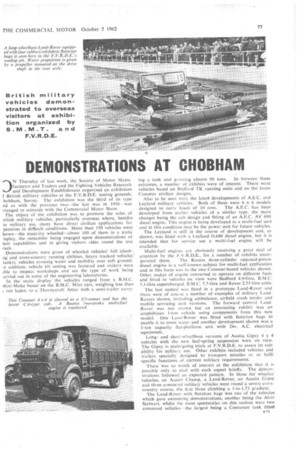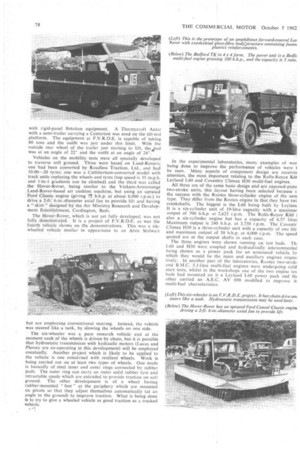DEMONSTRATIONS AT CHOBHAM
Page 79

Page 80

If you've noticed an error in this article please click here to report it so we can fix it.
DN Thursday of last week, the Society of Motor Manufacturers and Traders and the Fighting Vehicles Research and Development Establishment organized an exhibition f British military vehicles at the F.V.R.D.E. testing grounds, hobham, Surrey. The exhibition was the third of its type nd as with the previous two--the last was in 1956—was rranged to coincide with the Commercial Motor Show.
The object of the exhibition was to promote the sales of l'itish military vehicles, particularly overseas where, besides le military use, many have direct civilian applications for peration in difficult conditions. More than 150 vehicles were hown—the majority wheeled—about 100 of them in a static isplay, the remainder being engaged upori demonstrations of heir capabilities and in giving visitors rides round the test rack.
Demonstrations were given of wheeled vehicles' hill climb-, rig and cross-country running abilities, heavy tracked vehicles' tanks), vehicles crossing water and mobility over soft ground. n addition, vehicle tilt testing was featured and visitors were ible to inspect workshops and see the type of work being arried out in some of the engineering laboratories.
In the static display the vehicles ranged from a B.M.C. dini-Moke based on the B.M.C. Mini cars, weighing less than I ton laden, to a Thornycroft Antar with a semi-trailer carry
log a tank and grossing almost 90 tons. In between these extremes, a number of exhibits 'were of interest. There were vehicles based on Bedford TK running units and on the latest Commcr civilian designs.
Also to be seen were the latest developments of A.E.C. and Leyland military vehicles. Both of these were 6 x 6 models designed to carry loads of 10 tons. The A.E.C. has been developed from earlier vehicles of a similar type. the main changes being the cab design and fitting of an A.E.C. AV 690 diesel engine. This engine is being developed as a multi-fuel unit and in this condition may be the power unit for future vehicles.
The Leyland is still in the course of development and, as shown, was fitted with a Leyland 0.680 diesel engine, but it is intended that for service use a multi-fuel engine will be available.
Multi-fuel engines are obviously receiving a great• deal of attention by the F.V.R.D.E., for a number of exhibits incor porated them. The Rootes three-cylinder opposed-piston diesel engine is a well-known subject for multi-fuel application and in this form was in the two Commer-based vehicles shown. Other makes of engine converted to operate on different fuels and fitted in vehicles on view were Bedford 4.9-litre, B.M.C. 5.1-litre supercharged. B.M.C. 5.7-litre and Rover 2.53-litre units.
The last named was fitted in a prototype Land-Rover and there were of course a number of examples of military LandRovers shown, including ambulance, airfield crash tender and mobile servicing unit versions. The forward control LandRover was not shown but an interesting exhibit was an amphibious 1-ton vehicle using components from this new model. One Land-Rover was fitted with flotation bags to enable it to cross water and another development shown was a 1-ton capacity flat-platform unit with 24v. AC. electrical equipment.
Longand short-wheelbase versions of .Austin Gipsy 4 x 4 vehicles with the new leaf-spring suspension were on view. The Gipsy is undergoing trials at F.V.R.D.E. to assess its suitability for military use. Other exhibits included vehicles and trailers specially designed to transport missiles or to fulfil specific functions of current Military requirement& There was 'so much of interest at the exhibition that it is possible only to deal with each aspect briefly. The demonstrations followed an expected pattern. In those for wheeled vehicles, an Austin Champ, a Land-Rover, an Austin Gipsy and three armoured military vehicles Went round a severe crosscountry course, the first three climbing a 1-in-1.73 gradient.
The Land-Rover with flotation bags was one of the vehicles which gave Swimming demonstrations, another being the Alvis Stalwart. whilst the most spectacUlar.-.on this section were two armoured vehicles—the largest being. a „Centurion tank -fitted
with rigid-panel flotation equipment. A Thornycroft Antar with a semi-trailer carrying a Centurion was used on the tilt-test platform. The equipment at F.V.R.D.E. is capable of taking 90 tons and the outfit was just under this limit. With the outside rear wheel of the trailer just starting to lift, the.ped was at an angle of 22° and the outfit at an angle of 24°.
Vehicles on the mobility tests were all specially developed to traverse soft ground. Three were based on Land-Rovers; one had been converted by Roadless Traction, Ltd., and had 10.00-20 tyres; one was a Cuthbertson-converted model with track units replacing the wheels and tyres (top speed is 35 m.p.h. and 1-in-1 gradients can be climbed) and the third was called the Hover-Rover, being similar to the Vickers-Armstrorigs Land-Rover-based air cushion machine, but using an uprated Ford Classic engine (giving 71 b.h.p. at about 6,000 r.p.m.) to drive a 2-1t: 6-in.-diameter axial fan to, provide lift and having a " skirt " designed-by the Air Ministry Research and Development Establishment, Cardington, Beds.
The Hover-Rover, which is not yet fully developed, was not fully-demonstrated. It is a project of F.V.R.D.E. as was the fourth vehicle shown on the demonstrations. This was a sixwheeled vehicle similar in appearance to an Alvis Stalwart
but not employing conventional steering. Instead, the vehicle was steered like a tank, by slowing the wheels on one side.
The six-wheeler was a pure research vehicle and at the moment each of the wheels is driven by chain; but it is posSible that hydrostatic transmission with hydraulic motors (Lucas and Plessey are co-operating in this development) will be employed eventually. Another project which is likely to be applied to the vehicle is one concerned with resilient wheels. Work is being carried out on at least two types of wheels. One made is basically of steel inner and outer rings connected by rubber pads. The outer ring can carry an outer solid rubber tyre and retractable spuds which are extended to provide traction on soft ground. The other development is of a wheel having rubber-mounted " feet " at the periphery which are mounted on pivots so that they adjust themselves automatically (at an angle to the ground) to improve traction. What is being done is to try to give a wheeled vehicle as good traction as a tracked vehicle.
r "7. In the experimental laboratories, many examples of wor being done to improve the performance of vehicles were t be seen. Many aspects of component design are receivin attention, the most important relating to the Rolls-Royce K6( Leyland L60 and Coventry Climax H30 multi-fuel engines.
All three are of the same basic design and are opposed-pisto two-stroke units, this layout having been selected because c the success with the Rootes three-cylinder engine of the sam type. They differ from the Rootes engine in that they have twi crankshafts. The biggest is the L60 being built by Leylanc It is a six-cylinder unit of 19-litre capacity with a maximur output of 700 b.h.p. at 2,625 r.p.m. The Rolls-Royce K60 i also a six-cylinder engine but has a capacity of 6.57 litres Maximum output is 240 b.h.p. at 3,750 r.p.m. The Coventr Climax H30 is a three-cylinder unit with a capacity of one lift and maximum output of 30 b.h.p. at 4,000 r.p.m. The speed quoted are at the output shafts in each case.
The three engines were shown running on test beds. Th, L60 and I-130 were coupled and hydraulically interconnected being shown as a power pack for an armoured vehicle fo which they would be the main and auxiliary engines respec tively. In another part of the laboratories, Rootes two-stroki and B.M.C. 5.1-litre multi-fuel engines were undergoing cold start tests, whilst in the workshops one of the two engine tes beds had mounted on it a Leyland L60 power pack and th( other carried an A.E.C. AV 690 modified to improve it multi-fuel characteristics.
























































































































